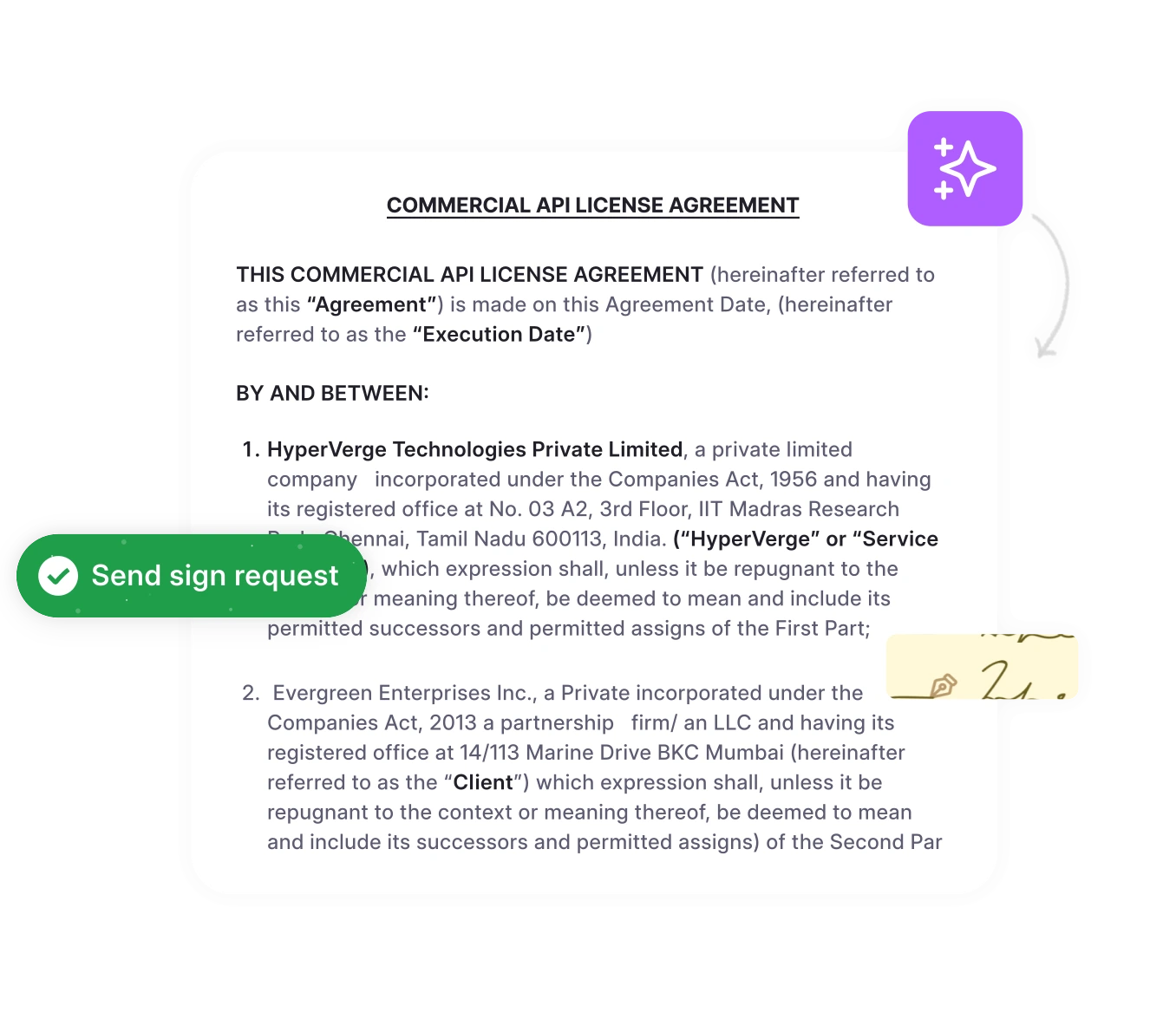Are you unaware of compliance risks and missed obligations related to your contracts? Do you struggle with ensuring every contract obligation and commitment is followed? If so, there are chances you might be struggling with maintaining compliance with your contracts.
For many organizations, maintaining compliance with contracts is a major challenge. With continuously evolving business goals, legal frameworks, and contract requirements, compliance is often overlooked—leading to non-compliance, contract breaches, lawsuits, and penalties.Read this blog to know how to effectively maintain and manage contract compliance. Learn the importance, responsibilities, processes, and best practices surrounding contracts’ legal compliance. Let’s start by understanding what it means to comply with agreements.
What is contract compliance?
Contract compliance refers to ensuring that contractual parties involved in the deal adhere to the agreed-upon terms, conditions, and. It involves monitoring and managing obligations, deadlines, and deliverables to avoid breaches and legal disputes. Essentially, it’s about making sure everyone follows what they agreed to.
Let’s understand it better with a simple example.
A business owner running a fast food outlet signs a contract with a supplier to deliver raw materials by the 29th of each month. If the supplier misses the deadline or delivers incorrect raw materials, the business owner risks potential losses due to disruptions in their production schedule.
Contract compliance helps the business owner ensure the supplier meets its delivery and quality obligations. If the supplier fails to comply with the contract, it will face legal consequences.
Say Goodbye To Compliance Worries
Automate compliance management and obligation tracking with HyperStart CLM’s powerful AI.
Why is effective contract compliance important?
Ensuring contract compliance is crucial for maintaining the smooth operation and success of a business. Here’s how effective contract compliance management can benefit your business:
1. Reduces legal risks and financial penalties
Non-compliance often results in fines, penalties, and disrupted operations. In fact, a Globalscape report states that organizations experience revenue losses worth over USD 4 million due to non-compliance. Effective compliance management ensures that all contractual obligations are fulfilled, avoiding financial penalties related to non-compliance. This proactive approach protects your business from unexpected expenses.
2. Enhances operational efficiency
Contract compliance ensures that every obligation within the contract is met as promised, leading to smoother business operations. When deadlines are met on time, services are delivered according to agreed terms, and payments are made punctually, businesses operate without any unnecessary interruptions. By preventing delays and ensuring consistent performance, contract compliance helps maintain a steady workflow and reduces the risk of operational bottlenecks.
3. Strengthens business relationships
Contract compliance is the foundation of business trust. You consistently adhere to contract terms and demonstrate reliability to your partners and clients. This foundation of business trust establishes strong long-term business relationships. When all parties can rely on each other to meet their business requirements, it promotes repeat business and enduring partnerships.
4. Improves financial management
Contract compliance provides better control over your financial commitments. You can maintain a healthy cash flow and avoid late or missed payments by maintaining payment schedules and ensuring timely invoicing. A clear view of your financial obligations allows for more accurate budgeting and financial planning.
5. Upscales reputation
When you maintain contract compliance, you establish a strong reputation for reliability in the market. Clients and other businesses are likelier to engage with a company that consistently honors its agreements. This positive reputation attracts more business opportunities, ultimately contributing to revenue and company success.
6. Facilitates regulatory compliance
In many industries, regulatory compliance is closely tied to contract compliance. Ensuring your contracts adhere to regulatory requirements protects your business from fines and sanctions. Maintaining regulatory compliance helps you avoid legal repercussions and damage to your company’s credibility.
Who is responsible for contract compliance?
Contract managers
Contract managers are primarily responsible for overseeing the entire contract lifecycle. They ensure that all contractual terms and conditions are met, track key dates and statuses, and manage any amendments, renewals, or terminations. By monitoring compliance closely, contract managers help prevent breaches and ensure all parties fulfill their obligations.
Legal department
The legal department plays a crucial role in contract compliance by providing expertise in drafting and reviewing contracts. They ensure that contract templates are legally sound and compliant with regulations. Additionally, the legal team offers guidance on interpreting contract terms and resolving disputes, ensuring that the company meets all legal and regulatory requirements.
Project managers
Department heads and project managers ensure their teams understand and follow contract requirements. They play a key role in executing the contract terms, such as delivering products or services on time and maintaining quality standards. By closely managing their teams, they ensure that day-to-day operations align with contractual obligations.
Finance department
The finance department is responsible for managing the financial aspects of contracts, such as invoicing, payments, and financial reporting. They ensure that payments are made and received according to the terms of the contract, maintaining accurate financial records. By doing so, they help prevent financial discrepancies and ensure that the company and its contract stakeholders meet their financial commitments.
How to ensure contract compliance
To ensure contract compliance, follow these key steps:
1. Establish a contract compliance framework
Start by developing policies and templates that outline compliance steps to standardize contract management.
Next, implement standard, legally approved templates for agreements such as NDAs and vendor contracts to minimize errors.
Furthermore, centralize all contracts and related documents in a single repository to ensure easy access and efficient management.
Set clear approval criteria to prevent unauthorized agreements and ensure that all contracts meet organizational and legal standards.
2. Assign roles and responsibilities
Moving on, define clear roles and permissions within your contract management software to manage responsibilities effectively.
Support your contract management team by utilizing task assignments, reminders, and notifications to oversee compliance.
Designate specific individuals or teams for compliance oversight and leverage reporting tools to monitor their activities and ensure that all obligations are met.
3. Implement processes and procedures
To further enhance compliance, use reporting tools for regular audits and reviews to proactively identify and address potential issues.
Track vendor performance through alerts and dashboards to ensure they meet their contractual obligations.
Utilize calendar and reminder features to manage important contract dates and deadlines, preventing any missed obligations. It’s also crucial to keep a document updated with legal changes to ensure that contracts remain compliant.
Configure procedures for dispute resolution within your software to manage issues efficiently and document resolution steps.
4. Leverage technology
Automate compliance tasks by utilizing software features that streamline contract creation, tracking, and management. This reduces errors and ensures consistent adherence to compliance standards.
Make use of real-time tracking and reporting capabilities to gain up-to-date visibility into contract performance and compliance status.
Finally, enhance your compliance management by integrating with other tools, such as document editors and e-signature platforms, to streamline contract handling and execution.
The role of CLM software in ensuring contract compliance
Earlier, parties used to rely on manual efforts to comply with contracts, but it was an error-prone method. Contract management software automates and streamlines the entire contract management process. Here’s how CLM software like HyperStart can automate your approach to compliance:
1. Centralized repository
Contract lifecycle management software provides a centralized repository for all your contracts. This means every contract is stored in a single accessible location. It reduces the risk of lost or misplaced documents. A centralized repository promotes transparency across the organization by ensuring all authorized team members can easily access the latest contract versions and related documents.
2. Automated alerts and reminders
One of the standout features of contract management software is its ability to send automated alerts and reminders. These alerts remind you of upcoming important dates or deadlines, such as renewal dates, payment schedules, and compliance milestones. By receiving timely reminders, you can take proactive actions to ensure legal compliance and avoid penalties or breaches.
With CLM tools like HyperStart CLM, you do not need to worry about deadlines and renewal dates. Whenever an obligation is near, you get automated alerts—giving you the needed visibility over contractual commitments.
3. Real-time monitoring and reporting
CLM software enables real-time monitoring and contract compliance reporting. You can track compliance metrics, identify potential risks, and generate detailed reports on contract status. This real-time visibility helps you make informed decisions and quickly address any issues that could impact compliance.
4. Workflow automation
With CLM software, you can automate key workflows involved in contract management. From contract drafting and reviewing to approval and execution, automation ensures that each step follows a predefined process. It reduces manual errors and speeds up the contract lifecycle. Automated workflows also ensure that all necessary approvals are obtained and compliance checks are completed before a contract is finalized.
Tools like HyperStart CLM allow you to create no-code workflows, so you can automate and customize contract management processes without any coding knowledge. This feature simplifies complex tasks and reduces manual errors.
5. Compliance audits and analytics
CLM software offers tools for conducting compliance audits and analytics. You can perform regular audits to ensure that all contracts meet regulatory and internal compliance standards. Advanced analytics features help you track contract renewals, check compliance performance over time, and identify areas for improvement.
These are a few ways in which using contract management software helps enhance contract compliance. Apart from using a contract management platform, there are certain best practices you can implement to further streamline the contract compliance monitoring process.
Simplify your compliance journey with HyperStart
HyperStart offers automated alerts, centralized document storage, and intuitive workflows. Focus on what matters most and grow your business.
5 Best practices for contract compliance management
Here are 5 best practices for effective compliance monitoring and management to help you ensure compliance throughout your contract portfolio:
1. Streamline the contract approval process
Use standardized workflows to streamline and speed up contract approvals, reducing bottlenecks and minimizing human error.
2. Clarify roles and responsibilities
Clearly define each team member’s role in contract management to ensure accountability and smooth collaboration at every compliance stage.
3. Establish clear and achievable KPIs
Set measurable KPIs for contract compliance to help monitor progress and quickly identify areas that need improvement.
4. Plan risk mitigation
Develop a risk assessment and mitigation plan to proactively address potential compliance issues and avoid costly penalties.
5. Perform regular compliance audits
Conduct periodic compliance audits to verify adherence to contract terms and uncover gaps that need immediate attention.
Automate compliance monitoring with HyperStart CLM’s powerful AI
Contract compliance tracking and management can be a daunting task, especially if you have a large contract portfolio to handle. But worry not, HyperStart CLM solves this challenge by automating routine contract compliance management.
With a 99% accurate AI engine and robust contract tracking features, HyperStart CLM automatically reports on contracts. Be it upcoming contract obligations or critical compliance responsibilities, HyperStart CLM ensures you stay on top of contracts.Still unsure? Book a demo with HyperStart CLM today to know more.











